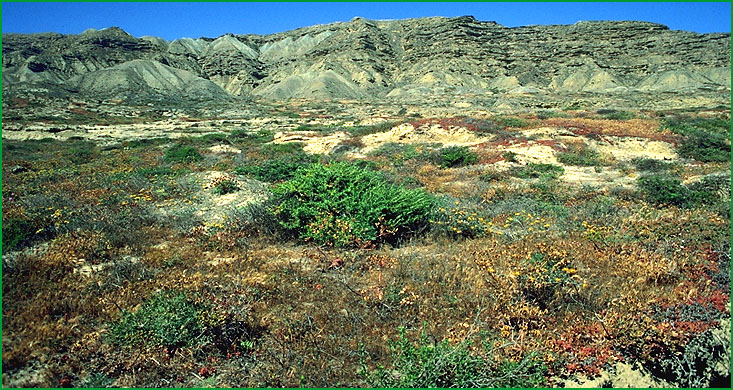 | Southern Channel Islands |
San Nicholas Island Ś Eric Vinson |
http://www.fs.fed.us/r5/projects/ecoregions/261bh.htm
This subsection includes San Clemente, San Nicolas, Santa Barbara, and Santa Catalina Islands. It has a hot and subhumid climate that is moderated by the ocean. MLRA 20.
Lithology and Stratigraphy. This subsection contains mostly Miocene volcanic rocks, Tertiary subvolcanic (hypabyssal) rocks, and, on San Clemente Island, marine sedimentary rocks of the Franciscan Complex. There are minor amounts of Pre-Cretaceous metamorphic and ultramafic rocks on San Clemente Island. San Nicolas Island is mostly Eocene sedimentary rock and a cover of Quaternary deposits.
Geomorphology. The mountains and hills of the southern Channel Islands and their submarine ridges trend northwest, unlike the northern Channel Islands. Santa Catalina Island is mountainous, with steep slopes. The other islands have broad gently sloping main ridges with moderately steep sideslopes, but very steep on the northwest side of San Clemente Island. San Nicolas Island is capped by a Quaternary marine terrace that has had sand blown up the northwest end of the island onto it. Mass wasting, fluvial erosion, wave erosion (coastal marine), and eolian erosion and deposition are the main geomorphic processes.
Soils. The main soils are mostly Typic Chromoxererts and Typic Chromusterts on volcanic rocks; Lithic, and Mollic Haploxeralfs of rocks of the Franciscan formation; Mollic Haploxeralfs, and Typic Natrustalfs on Eocene sedimentary rocks. Salts from the ocean accumulate in the soils, especially on San Nicolas Island. The soils are well drained. The soil temperature regimes are thermic and isothermic. Soil moisture regimes are xeric and ustic.
Vegetation. The predominant natural plant communities include California sagebrush series, Mixed chaparral shrublands, Coast live oak series, and Coast prickly-pear series. Dunes and adjacent uplands with a cover of eolian sand support a succession of plant communities, from bare dune through Sand-verbena - beach bursage series.
Characteristic series by lifeform include:
Dune vegetation: Sand-verbena - beach bursage series.
Grasslands: California annual grassland series.
Shrublands: Bigpod ceanothus series, Black sage series, California sagebrush series, California sagebrush - black sage series, Chamise series, Coast prickly-pear series, Mixed sage series, Scrub oak series, White sage series.
Forests and woodlands: Catalina ironwood stands, Island oak series.
Climate. The mean annual precipitation is about 12 to 15 inches. It is all rain. Mean annual temperature is about 54░ to 60░ F, with 5 to 10░ F differences between summer and winter means. The mean freeze-free period is about 365 days.
Surface Water. Runoff is rapid. There are few streams, especially few in volcanic terrain, and all of them are dry through the summer. Natural lakes are absent.
